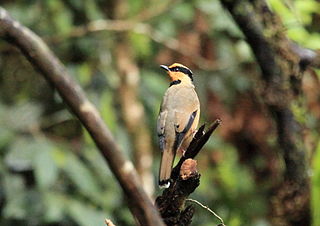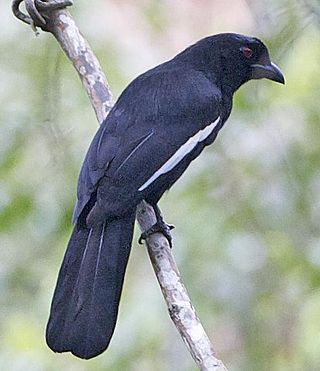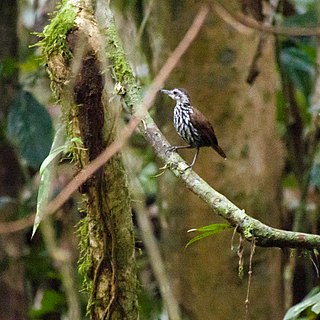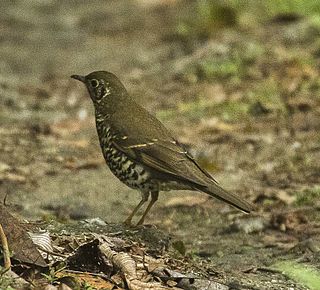
The Bonin thrush, also known as Kittlitz's thrush or the Bonin Islands thrush, is an extinct species of Asian thrush. It is sometimes separated as the only species of the genus Cichlopasser. The only place where this bird was found was Chichi-jima in the Ogasawara Islands; it might conceivably have inhabited Anijima and Otōtojima, but this has not been borne out by observations or specimens. The species was only once observed by a naturalist, its discoverer Heinrich von Kittlitz. He encountered the thrush in the coastal woods where it usually kept to the ground; it may have been ground-nesting. The only specimens ever taken are in the Naturalis in Leiden (1), the Naturhistorisches Museum in Vienna (1), the Senckenbergmuseum in Frankfurt (1) and in the Zoological Museum, St. Petersburg (2).

The Bassian thrush, also known as the olive-tailed thrush, is a medium-sized mostly insectivorous thrush found from northern Queensland to southeastern Australia; it also occurs in Tasmania, on some larger islands of Bass Strait, and on Kangaroo Island. The thrushes range from 27 to 29 cm in length and average 100 g (3.5 oz).

The Bornean spiderhunter is a species of bird in the family Nectariniidae. The scientific name commemorates British colonial administrator and zoological collector Alfred Hart Everett.

The fruithunter or fruit-hunter, also known as the black-breasted fruit-hunter, is an enigmatic species of bird currently placed with the typical thrushes in the family Turdidae. It is endemic to forests on the south-east Asian island of Borneo.
The Tanahjampea monarch or white-tipped monarch is a species of bird in the family Monarchidae. The scientific name commemorates British colonial administrator and zoological collector Alfred Hart Everett.

The Bornean whistling thrush is a species of bird in the family Muscicapidae. It is found in Indonesia and Malaysia, where it is endemic to the island of Borneo. Its natural habitat is subtropical or tropical moist montane forests.

The Malayan black magpie is a species of bird in the family Corvidae. Despite its name, it is neither a magpie nor, as was long believed, a jay, but a treepie. Treepies are a distinct group of corvids externally similar to magpies.

The Bornean wren-babbler is a species of bird in the family Pellorneidae. It is found in Brunei, Indonesia, and Malaysia, where it is endemic to the island of Borneo. Its natural habitats are subtropical or tropical moist lowland forest and subtropical or tropical swampland. It is threatened by habitat loss.
The chestnut-crested yuhina is a species of bird in the white-eye family Zosteropidae. The species has been included in the genus Staphida, along with the Indochinese yuhina and the striated yuhina of mainland Asia, and all three have been considered a single species. The scientific name commemorates British colonial administrator and zoological collector Alfred Hart Everett.

The long-tailed thrush is a species of bird in the family Turdidae. It is found from the central and eastern Himalayas to south-central and south-western China. Its natural habitats are subtropical or tropical moist montane forests and subtropical or tropical high-altitude shrubland.

The russet-tailed thrush is a species of bird in the family Turdidae, closely related to the more widespread Bassian thrush. It is found in eastern Australia and Papua New Guinea.

The fawn-breasted thrush is a species of bird in the family Turdidae. It is endemic to the Tanimbar Islands in Indonesia. Its natural habitat is subtropical or tropical moist lowland forests. It is threatened by habitat loss.
The Makira thrush, also known as the San Cristobal thrush, is a species of bird in the family Turdidae. It is endemic to the Solomon Islands. Its natural habitat is subtropical or tropical moist lowland forests. It is threatened by habitat loss.

The alpine thrush is a species of bird in the thrush family.

The long-billed thrush is a species of bird in the family Turdidae. It is found from the Himalayas to Myanmar and Vietnam. Its natural habitat is subtropical or tropical moist montane forests.
The black-backed thrush or New Britain thrush is a species of bird in the family Turdidae. It is endemic to Papua New Guinea where it occurs on the islands of New Britain, Umboi and Bougainville. Its natural habitats are temperate, subtropical or tropical moist lowland forests and subtropical or tropical moist montane forests.
The Guadalcanal thrush is a species of bird in the family Turdidae. It is endemic to the Solomon Islands. Its natural habitat is subtropical or tropical moist montane forests.

Hose's langur is a species of primate in the family Cercopithecidae endemic to the island of Borneo, including Brunei, Kalimantan (Indonesia), and East Malaysia. Its natural habitat is subtropical or tropical dry forests. It is threatened by habitat loss. It was first identified in Kutai National Park and Sangkulirang Peninsula, East Kalimantan, Indonesia, in 1985.

The Dulit partridge, also known as Hose's partridge, has been considered a distinctive subspecies of the long-billed partridge, a bird in the Phasianidae, or pheasant, family. It is endemic to Borneo, where it appears to be separated altitudinally from the nominate subspecies, and is often considered now to be a full species, Rhizothera dulitensis. It is little-known, rare, and has not been recorded since 1937.

The Himalayan thrush or Himalayan forest thrush is a species of bird described in 2016 and separated out from the alpine thrush Zoothera mollissima with which they were formerly lumped. The species is separated on the basis of phylogenetic studies that suggest that the population diverged from the common ancestor at least 3 million years ago. The alpine thrush breeds above the tree line whereas the Himalayan thrush breeds in forested habitats. The species breeds from Sikkim and Darjeeling in India and extends east into Tibet and further east into northwest Yunnan in China. The species differs in its song from that of the alpine thrush. The Himalayan thrush has a more musical call while that of the Alpine thrush is raspy and grating. A newly discovered Himalayan forest thrush bird was named after the birdman of India, Ornithologist Dr.Salim Ali. The name of the bird is "Zoothera salimalii". A fruit bat is also named after him "Latidens salimalii"
















